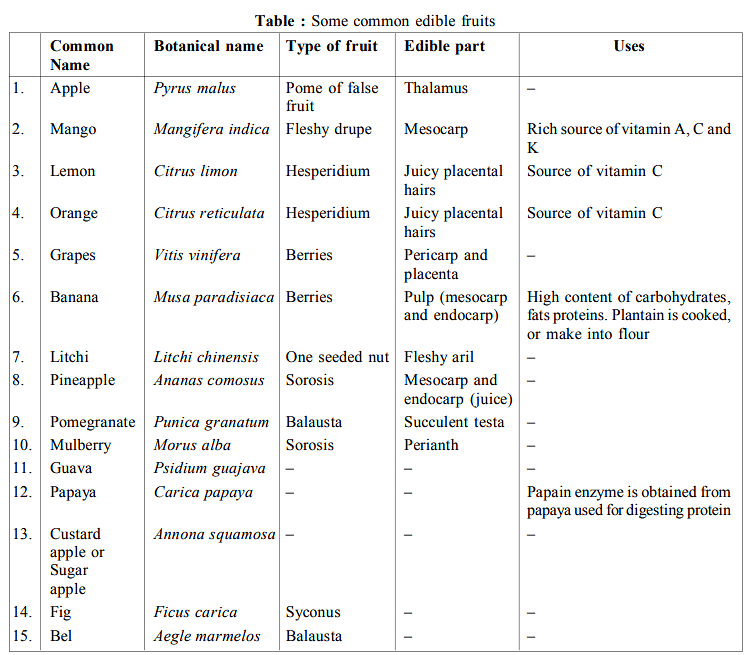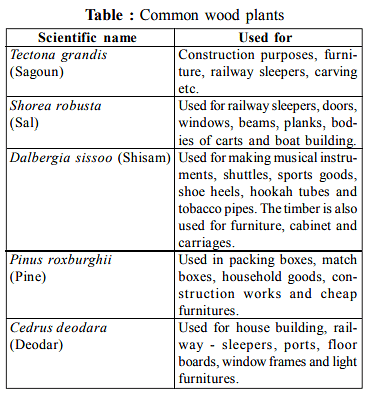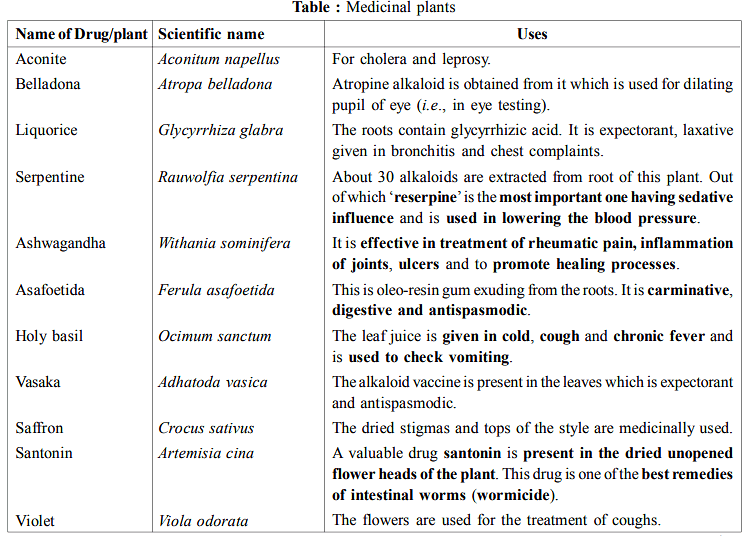UPSC Exam > UPSC Notes > Botany Optional for UPSC > Plants as Sources for Food
Plants as Sources for Food | Botany Optional for UPSC PDF Download
Food Plants
Food plants can be categorized into various groups, including cereals, pulses, nuts, vegetables, fruits, spices, and beverages.
Cereals
- The term "cereals" originates from the Roman goddess Ceres, who was considered the giver of grains.
- Cereals belong to the Poaceae family and are caryopsis fruits.
- They can be classified as major (e.g., paddy, wheat, maize), minor (e.g., rye, barley, oats), small grains, and millets (e.g., jowar).
- Rice (Oryza sativa) likely originated in Indochina or India and is a principal cereal in tropical regions.
- Some key rice-growing states in India include A.P., Assam, Bihar, M.P., Maharashtra, Tamilnadu, and West Bengal.
- Rice grains are a staple food and also used as stock and poultry feed.
- Rice plants are typically 60-120 cm tall herbs with an adventitious fibrous root system.
- The grain contains around 90% carbohydrates, 8-10% proteins, 1% fats, and about 1% minerals.
- The polished rice has lower nutritive value as it lacks proteins, vitamins, and fats.
- Common rice varieties include Basmati 307, IR-24, IR-48, Krishna, Jaya, Padma, Ratna, Pankaj, Jamuna, Sabermati, ADT-27, and more.
- New rice varieties are developed at institutions like the Indian Agricultural Research Institute, New Delhi, and the International Rice Research Institute, Manila, Philippines.
- Rice flour is used in various products, including pastries, puddings, and ice creams. Rice bran oil is used in soap and cosmetics production, and sake is made from fermented rice.
Wheat
- Wheat is the principal food in temperate countries and the second staple food in India.
- Wheat has multiple origins, including soft wheat from southwest India and Afghanistan, Durum wheat from Algeria and Greece, and Einkorn from Asia Minor.
- Wheat plants are annual herbs with grains containing 69-70% carbohydrates.
- The USA is the world's largest wheat-producing country.
- Major wheat-producing states in India include Bihar, Madhya Pradesh, Maharashtra, Punjab, Rajasthan, and Uttar Pradesh.
- Wheat grains are sown in India in the months of October/November as part of the Rabi crop.
- There are at least nine kinds of wheat, including Einkorn, Emmer, Spelt, Polish wheat, Poulard wheat, Club wheat, Durum wheat, Common wheat, and Tinopheevi.
- High-yielding wheat varieties include Kalyan Sona (HD-1593), Sonalika (HD-1553), Pratap (HD-1981), and disease-resistant varieties like HD-2135, HD-2189, Lerma Rojo, Sonara-64, Arju, Hera, Janak, WH-147, KSML-3, C-306, and UP-115.
- The flour from wheat is used for various purposes, and the straw is utilized as fodder. Wheat straw is also used to make corrugated paper.
Maize (Corn)
- Maize (Zea mays), often called "Indian corn," is native to the Americas and considered a gift from the Americas to the world of cereals.
- In India, maize is grown in Andhra Pradesh, Bihar, Jammu-Kashmir, Madhya Pradesh, Punjab, and Uttar Pradesh as a Kharif crop.
- Important maize varieties include Ganga Safed-2, Ganga-5, Him-123, Decan 101, Vijay, Ganga-9, Histarch, Jowahar, VL-54, Amber, Deccan, and more.
- Maize plants are tall herbs with heights ranging from 1 to 4.5 meters, featuring adventitious fibrous and stilt root systems.
- Maize grains are deficient in amino acids lysine and tryptophan but rich in thymine.
- Maize is used to make various products like popcorn, flakes, poultry grit, animal feed, corn starch, industrial alcohol, syrup, and an artificial fiber called Zein.
Barley
- Barley (Hordeum vulgare) was one of the first domesticated cereals.
- It is sown as a Rabi crop and used to make malt, whiskey, and other alcoholic beverages. Barley flour is used for making chapatis.
Oats
- Oats (Avena sativa) are highly nutritious among cereals, containing high levels of proteins, fats, and minerals.
- The USA is the world's leading producer of oats.
- Oatmeal is used in various products like cakes, biscuits, etc., but not for bread due to its lack of gluten.
Rye
- Rye (Secale cereale) is more recently domesticated compared to other cereals.
- It is mainly used to prepare bread due to its gluten content.
Triticale
- Triticale (Triticosecale) is a man-made cereal produced by hybridization between wheat (Triticum sps.) and European rye (Secale cereale).
- It resembles wheat but has shriveled grains.
Millets
- Millets are small-sized grains with edible endosperm.
- Important millets include jowar (Sorghum vulgare), bajra (Pennisetum typhoides), ragi (Eleusine coracana), common millet (Panicum miliaceum), foxtail millet (Setaria italica), and more.
- Some seeds of other plants are used like cereals and millets for food and are known as pseudocereals.
- Two widely used pseudocereals are buckwheat (Fagopyrum sagittatum or F. esculentum, known as Kuttu) and gorgon nut (Euryale ferox, known as Makhana).
Buckwheat
- The seeds of buckwheat are ground to make flour used for porridge, pancakes, etc., and it contains rutin, a compound used in treating hypertension and high blood pressure.
Pulses
- Pulses are a significant source of human food and belong to the Leguminosae family, characterized by their legume or pod-like fruit.
- Pulses contain proteins, carbohydrates, and oils.
- The high protein content in pulses is due to the presence of root nodules in legumes, which enable them to fix atmospheric nitrogen, thus increasing soil fertility.
- Pulse crops are beneficial for crop rotation and mixed cropping.
- Some important pulses include gram (Chick Pea), red gram (Pigeon Pea, Arhar, Tur), black gram (Urd), green gram (Mung), pea (Mattar), soybean, mat bean (Moth), lentil (Masur), red kidney bean (Rajmah), lablab, guar/cluster bean, cowpea/Lobia, and phaseolus lunatus.
- Soybean, in particular, contains 40% proteins, lower cholesterol, and LDL, as well as an anticancer ingredient called genistein. It also yields oil, and soybean milk is a refreshing drink.
- Lathyrism, a debilitating condition characterized by muscular weakness, tremors, and paraplegia, is caused by eating seeds of Lathyrus sativus. These seeds contain toxins like osteotoxin b-amino propionitrile (BAPN) and water-soluble neurotoxin b-N-oxalyl amino alanine (BOAA).
- Urease enzyme used in the estimation of urea in urine and blood is obtained from arhar.
- Ardil protein from groundnut (Arachis hypogea) is used in fiber manufacturing.
- The tree legume is Prosopis juliflora.
- Rotenone, a white crystalline substance, is obtained from dry roots of Derris and Lonchocarpus and is used in fish poisoning and as an insecticide.
Nuts
- Nuts are defined as simple, dry, indehiscent fruits with hard pericarps.
- Nuts are rich in protein (Prunus, Pistacia), oil (Cocos, Anacardium, Juglans), and carbohydrates (Castanea, Quercus).
- Cashew nuts (Anacardium) have seeds containing 47% fats, 22% carbohydrates, and 21% proteins. They are eaten raw or roasted and used to make beverages.
- Almonds (Prunus amygdalus) are native to the Mediterranean region. The trees produce drupes with sweet or bitter seeds.
- Pistachio nuts (Pistacia vera) originate from West Asia, with drupes containing green seeds that are eaten raw, roasted, or salted.
- English walnuts (Juglans regia) produce drupes with edible cotyledons and are valuable for their timber.
Vegetables
- Vegetables store food materials in different plant parts and can be categorized into earth vegetables (roots, stems, and leaves), herbage (leafy) vegetables, and fruit vegetables.

Spices
- Spices are plant parts used for flavoring.
- Spices can be obtained from underground parts (e.g., asafoetida, turmeric, ginger), bark (e.g., cinnamon), flowers (e.g., saffron, clove), fruits (e.g., red pepper, coriander, cumin, fennel, black pepper, long pepper), leaves (e.g., coriander, meetha neem), and seeds (e.g., cardamom, nutmeg, fenugreek).
- Spices like coriander and clove have medicinal properties, while others like chillies contain vitamins A, C, and E.
Beverages
- Beverages are classified as non-alcoholic (e.g., tea, coffee, cocoa, cola) and alcoholic (e.g., beer, wine, whisky, brandy, gin, rum, fenny).
- Non-alcoholic beverages like tea and coffee are made from leaves and seeds, respectively, and contain alkaloids like theine and caffeine.
- Alcoholic beverages are produced from various sources, including palm, barley, rice, date, sugar cane, grape, and maize. They involve fermentation or distillation processes.
- Fermented beverages include beer and wine, while distilled beverages include whisky, brandy, gin, rum, and fenny.
- Some beverages, like gin, have distinctive flavors due to the presence of specific plant components (e.g., oil of Juniperus in gin).
- Tea contains theine and tannin and has various grades, with young buds being used for the best quality.
- Coffee seeds contain caffeine, acting as a stimulant.
- Turmeric mixed with milk is used as a painkiller.
- The pungent taste of chillies is attributed to the volatile compound capsaicin, and they also contain vitamins A, C, and E.
Fruits
- Fruits are the ripened ovaries and their contents.
- Fleshy fruits are sweet and eaten raw.
- Some fruits are parthenocarpic, meaning they lack seeds.

Industrial Plants
- Industrial plants are those used to obtain raw materials for industrial purposes.
- Common industrial materials derived from plants include wood, latex, oils, gums, dyes, sugar, and paper.
Wood
- Forests not only have ecological benefits but also produce wood and industrial materials.
- Wood surpasses metals in terms of availability, affordability, toughness, strength, and elasticity.
- Wood primarily consists of secondary xylem, with spring wood forming in spring and autumn wood in autumn, characterized by light and dark colors, respectively.
- Wood comprises tracheids, vessels, fibers, and parenchyma, with variations in ray characteristics, grain, figure, and texture.
- Gymnosperms' wood, lacking vessels, is called non-porous wood.
- The arrangement of wood components is termed wood grain, and the size and quality of these elements make up the wood's texture.
- Reaction wood, responding to physical stress, includes compression wood and tension wood.
- Timber seasoning, the removal of moisture from wood, can be done through air seasoning and kiln seasoning.
- Specific wood types are used for particular items, such as cricket bats, hockey sticks, pencils, and gun stocks.
- Some woods from various trees include Indian blackwood, ebony wood, and redwood.

Sugar
- Sugar primarily comes from sugarcane (Saccharum officinarum), sugar beet (Beta vulgaris), and palm.
- Sugarcane stems contain about 80% juice.
- Glucose, the first sugar produced by green plants, is commercially obtained from starch.
- Fructose, or fruit sugar, is found in many fruits alongside glucose and is produced from inulin found in Dahlia and Helianthus roots.
- Mannose is not found freely in plants but can be extracted from Fraxinus ornus (Manna ash) juice.
- Maltose doesn't exist freely in plants but can be obtained from starch through diastase action.
- Molasses, the juice left after sugar crystallization, is used to make ethyl alcohol, rum, acetic acid, and glycerine. Bagasse, the fibrous residue, is used in paper and cardboard production.
- Other sugar-yielding plants include Phoenix sylvestris, Borassus flabellifer, and Caryota urens.
Paper
- Papermaking has historical roots in Egypt, using Cyperus papyrus.
- Paper is a sheet of felted or matted cellulose or synthetic fibers.
- Raw materials for paper production include wood fibers, cotton, and linen.
- Wood pulp comes from trees like Picea, Abies, and Betula lutea.
- Fine-grade paper is made from cotton and linen fibers.
- Bamboo pulp (Bambusa arundinacea) is used for printing paper.
Dyes
- Various parts of plants produce dyes used in the textile industry.
- Dyes come from roots (e.g., Berberis, Moringa), rhizomes (e.g., Curcuma), bark (e.g., Quercus, Tectona), leaves (e.g., Indigofera, Lawsonia), flowers (e.g., Butea, Carthamus), fruits (e.g., Mallotus, Rhamnus), seeds (e.g., Bixa, Wrightia), and gum resin (e.g., Garcinia).
Fibers
- Fibers, found in various plant parts, are crucial for clothing.
- Botanically, fibers are sclerenchymatous cells in different plant parts, mainly made of cellulose or hemicellulose with lignin deposition.
- Boehmeria nivea has the longest fiber, measuring 55 cm.
- Different plants, like Hibiscus cannabinus, Boehmeria nivea, Cannabis sativa, and Agave sisalana, yield fibers.
- The strongest and most durable fibers come from secondary phloem, used for ropes, brushes, and carpets.
- Textile fibers are categorized as surface fibers (e.g., cotton), soft fibers (e.g., jute, flax, hemp), and hard fibers (e.g., coir).
- Brush fibers are obtained from plants like palms and grasses.
- Planting and rough weaving fibers are used for hats, mats, and baskets, often derived from palms and grasses.
- Filling fibers come from plants like Bombax, Calotropis, and Typha.

Oils
- Oils are classified as essential or volatile oils and fatty or fixed oils.
- Essential oils are extracted through distillation, expression, or solvents and are used in perfumery or other industries.
- Essential oils used in perfumery come from plants like Cananga odorata, Jasminum spp., Lavandula officinalis, and Rosa spp.
- Other plants yield essential oils for different industries, such as Cinnamomum camphora (kapur), Eucalyptus spp., and Syzygium aromaticum (clove).
- Fatty oils include drying oils, semi-drying oils, non-drying oils, vegetable fats, and waxes.
- Drying oils form an elastic film, and sources include Glycine max, Juglans regia, and Linum usitatissimum.
- Semi-drying oils are found in Brassica spp., Gossypium spp., Helianthus annuus, Sesamum indicum, and Zea mays.
- Non-drying oils are contributed by plants like Arachis hypogea, Olea europaea, and Ricinus communis.
- Vegetable fats are obtained from plants like Cocos nucifera, Elaeis guineensis (palm), and Madhuca indica (mahua).
- Waxes are produced by plants like Calathea lutea, Ceroxylon andicola, Euphorbia antisyphilitica, Myrcia, and Simmondsia sinensis (jojoba).

Rubber
- Rubber is derived from the latex of various woody plants, primarily Hevea brasiliensis in the Euphorbiaceae family.
- Latex is tapped by making incisions in the bark and processed to obtain rubber.
- Vulcanization is done by heating rubber with sulfur.
- Other plants that yield rubber include species of Castilla, Ficus, Manihot, Parthenium, and Taraxacum.
- Additional latex products include gutta-percha from Palaquim gutta, chicle from Achras sapota (used for chewing gum), and balata from Manilkara bidentata.
Tannins, Resins, and Gums
- Tannins are complex organic substances, often glucosidal, used for tanning hides and inks.
- Tannins are obtained from various plant parts such as roots, bark, leaves, and fruits.
- Gums, complex carbohydrates, are used as adhesives, in printing, cosmetics, medicines, and more. They are obtained from plants like Acacia senegal, Sterculia urens, Butea monosperma, Boswellia serrata, and Achras sapota.
- Resins, oxidation products of essential oils, are used in paints and varnishes. They come from various sources and are classified as hard resins, oleoresins, and gum resins. Common examples include damars, copals, turpentines, and asafoetida.
Medicinal Plants
- Certain plants possess medicinal properties thanks to specific chemical compounds found in their various parts, which exert distinct physiological effects on the human body.
- Drug plants are categorized based on the specific plant organ from which medicinal substances are derived.
This categorization is outlined in the table below:

The document Plants as Sources for Food | Botany Optional for UPSC is a part of the UPSC Course Botany Optional for UPSC.
All you need of UPSC at this link: UPSC
|
179 videos|143 docs
|
Related Searches
















